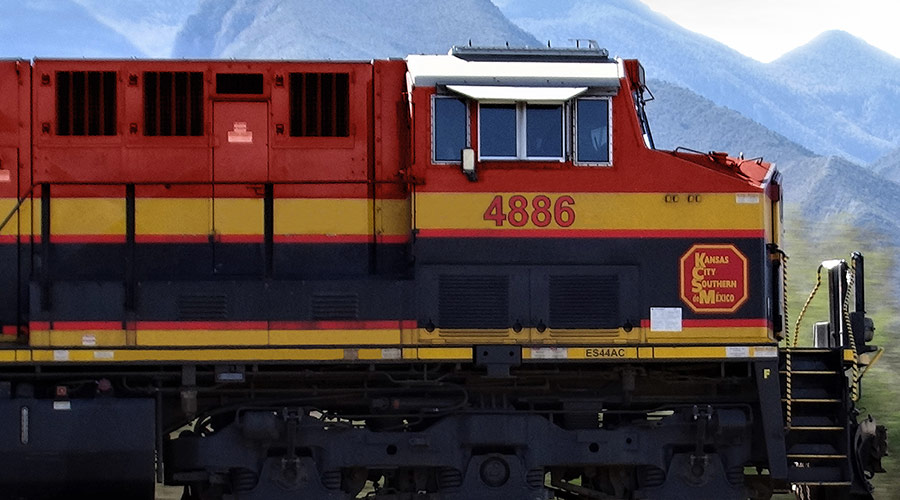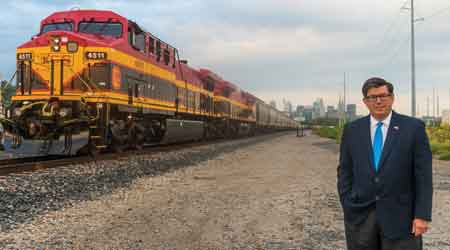Stay updated on news, articles and information for the rail industry
July 2019
Rail News: CSX Transportation
Kansas City Southern employs PSR to improve service performance, forge a traffic-growth foothold
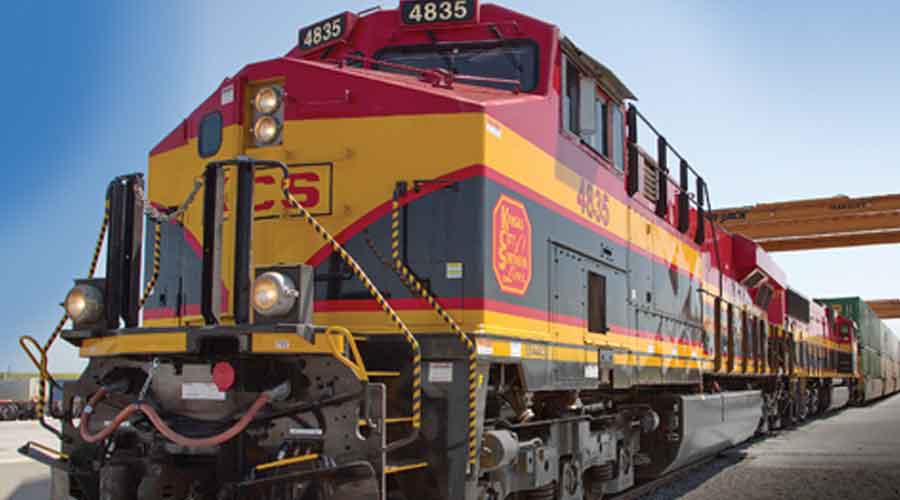
By Jeff Stagl, Managing Editor
Last year, Kansas City Southern set records for annual revenue, adjusted operating income and adjusted earnings per share. The Class I followed that up with best-ever revenue and adjusted operating income in the first quarter.
Those financial results typically might prompt high-fives among senior management, but not at KCS. Some outcomes didn’t meet senior executives’ expectations — business growth chief among them.
There were a wealth of traffic-building opportunities both in the United States and Mexico that couldn’t be seized because of network congestion, especially around the border between those nations. Plus, severe weather, a teachers’ strike in Mexico and other issues — such as locomotive failures — hampered operations.
Senior execs were particularly disheartened about the railroad’s inability to capture crossborder traffic in 2018 they believed was there for the taking. That segment accounts for more than 40 percent of annual volume.
Adding to the discouragement: the not-very-fluid railroad didn’t fulfill many customers’ service needs and not-as-hoped-for results didn’t meet shareholders’ expectations, senior execs say.
So, KCS’ top brass sought a means to greatly improve both operational and financial performance. Similar to other Class Is of late, their chosen method is precision scheduled railroading (PSR). KCS is adopting PSR principles through an effort that began late last year and kicked into high gear in Q1.
The Class I crafted a mantra — service begets growth — to emphasize the correlation between optimal operational performance and accelerated business generation. Senior execs believe a fluid and resilient railroad is much better positioned to capitalize on major business growth opportunities, the ongoing trade and tariff concerns surrounding Mexico notwithstanding. For the past several years, several traffic sectors have shown great promise, including refined petroleum products, intermodal, automotive and petrochemicals.
Already embraced by every other Class I except BNSF Railway Co., PSR calls for shifting the operational focus from moving trains to moving cars. The strategy helps improve asset and resource utilization, and spur fluidity by minimizing car classification events, balancing train movements, and reducing manpower and rolling stock needs.
For KCS, the projected benefits from PSR include improved velocity, less car dwell, fewer train starts, increased labor productivity, additional capacity, lower costs, and higher profitability and customer satisfaction.
It’s crucial that KCSers acknowledge the need to improve to help instill change, says Patrick Ottensmeyer, the Class I’s president and chief executive officer.
“We left growth opportunities behind. We came in sixth out of the seven Class Is on revenue and volume growth last year — volume growth was 1 percent, so tepid at best,” he says. “There needs to be a higher degree of cross-functional engagement and open-mindedness.”
KCS’ network requires more consistency and balance so “we don’t cut ourselves short” when volumes ramp up and opportunities emerge, he says.
“We’re confident that PSR will help us take advantage of the [burgeoning] growth areas for the next five years, and beyond,” Ottensmeyer says.
Yet, PSR wasn’t chosen as the operational turnaround strategy to keep pace with the other Class I adopters or join a growing trend. Since KCS interchanges a lot of traffic with other Class Is — and is “surrounded” by Union Pacific Railroad, its largest interchange partner — similar operating strategies make sense, says Ottensmeyer.
“We can synch up better with UP, and not miss a beat at interchanges,” he says.
Essentially, KCS has to adopt PSR to not only boost service performance, but lower its operating ratio (OR), says Citi Research analyst Christian Wetherbee.
‘Can’t be the OR outlier’
The railroad’s 2018 adjusted OR of 64.2 was flat versus 2017’s figure, while the Q1 ratio hit 76.2 compared with 65.8 a year earlier. The Class I is seeking a 60 or 61 OR by 2021.
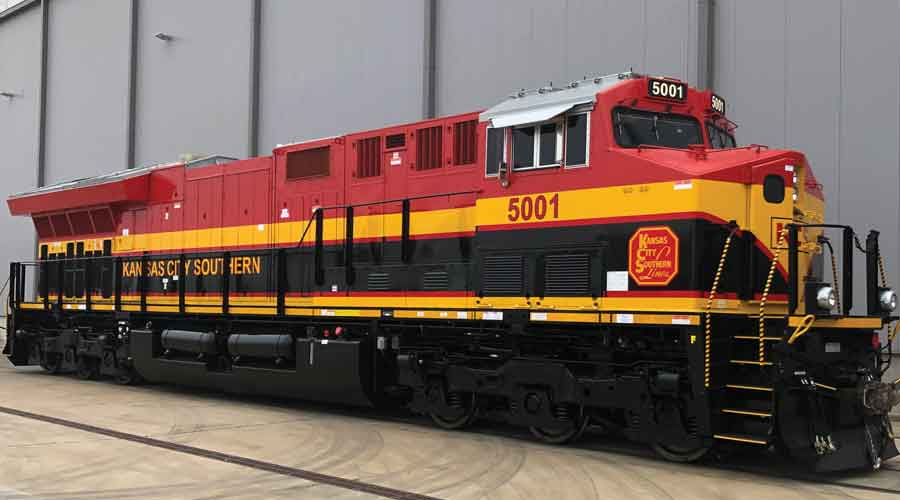
“They can’t be the outlier, the one with a higher OR than its peers,” says Wetherbee, who follows KCS. “PSR helps improve operations and makes them more efficient. They then can have a better product to sell in the field, and get a better price for that product.”
KCS has a bold view of PSR as a growth driver, something always espoused by E. Hunter Harrison, said independent rail industry analyst and Progressive Railroading columnist Tony Hatch in an online commentary.
Harrison — who died in December 2017 — championed the operating strategy and implemented it at CN, Canadian Pacific and CSX.
For Hatch, the key takeaway is that KCS is seeking change not just to please the lowest common denominator, but to achieve financial and operational objectives.
The organizational push toward achieving those objectives started in December 2018, when KCS hired PSR expert Sameh Fahmy as a management consultant. He was in the midst of helping CSX adopt PSR in a similar role under CEOs Harrison and James Foote.
Fahmy previously served CN for 23 years, lastly as senior vice president of engineering, mechanical and supply management. Working with CEOs Harrison and Claude Mongeau at CN — which long has employed PSR — Fahmy helped cut train delays, boost rolling stock availability and cut expenses.
One of Fahmy’s first orders of business was visiting KCS’ bustling yard in Monterrey, Mexico. The Class I serves about 600 customers near the facility, 150 of which are very active, so a lot of car switching is performed each day.
While at the yard in December, there were so many cars, Fahmy couldn’t see any tracks. Although a full yard could be an indication of healthy traffic, it’s also a sign of heavy congestion, meaning cars can’t be switched efficiently and dwell time increases, he says.
By working with customers to minimize car switches, employing PSR to block trains at origins and improving service designs, 1,000 cars were taken out of the yard in a few months. KCS also worked to reduce inventory at Sanchez Yard in Nuevo Laredo, Mexico.
In early February, the Class I added Fahmy to the senior leadership team — as executive VP of precision scheduled railroading — to spur similar fluidity results elsewhere and help guide other PSR objectives.
Hot target: Houston
Another key target was Houston, a Chicago-like region in terms of high traffic and heavy congestion, especially since Hurricane Harvey struck in 2017. KCS operates and interchanges in the area with BNSF Railway Co., UP and the Port Terminal Railroad Association. KCS’ interline service in Houston mostly involves traffic moving to and from Mexico.
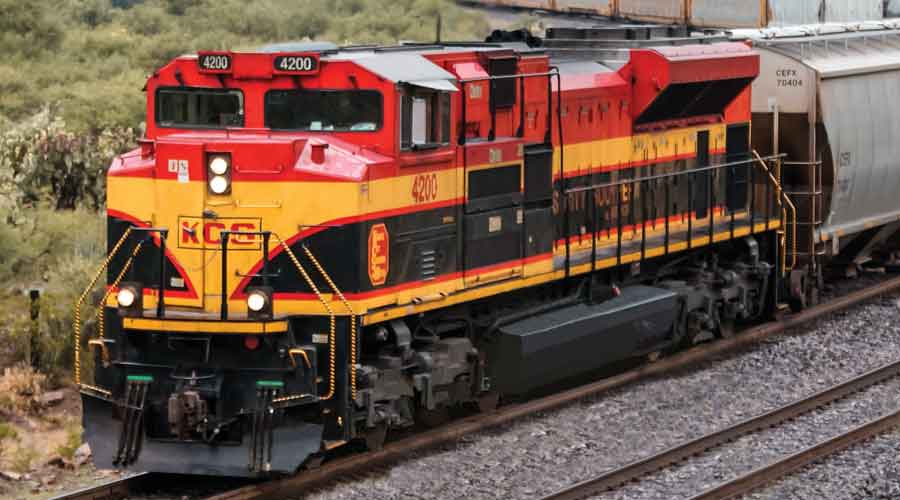
The Class I’s complex Houston terminal hadn’t bounced back from the hurricane, and in late 2018 was oversubscribed with equipment that caused system sluggishness, says KCS EVP and Chief Operating Officer Jeff Songer.
The Houston area is vital to KCS because of growing refined petroleum products and plastics business in the Gulf Coast region, and the plethora of trains making their way from U.S. origins to Mexico.
Since inefficiencies in Houston can impact the entire network — leading to trains bunching in other areas — reducing congestion there is the biggest PSR-related challenge, Fahmy says.
KCS is working both alone and with UP to consolidate southbound trains to preserve limited train slots in the area.
The Class Is also are jointly trying to improve the flow of traffic across the international bridge at Laredo, Texas. In addition, KCS is exploring shorter routes around Houston to avoid pinch points, reduce crew starts and boost fuel efficiency.
Similar efforts are required systemwide to make operations more reliable and resilient, says Fahmy.
“We are taking an intensive look at trains and delays, and a fresh look at the scheduling of trains,” he says.
Sometimes, operational benefits can be gained by moving a crew change about 500 feet so a train going in the opposite direction isn’t blocked.
“It can be small stuff like that,” Fahmy says.
KCS is fortunate that some of the other Class Is are implementing PSR at the same time so the railroads can combine automotive and manifest traffic and generate synergies, he says.
But KCS hasn’t been very fortunate with equipment failures of late. Locomotive failures have caused train delays totaling about 35 hours per day.
So, more modern and reliable motive power now has entered the fleet. In Q1, KCS began taking delivery of 50 Tier 4 Evolution™ Series locomotives it ordered from Wabec Corp.’s GE Transportation. The Class I anticipated delivery of all the units by June’s end.
As new models arrived, the least reliable locomotives were removed from the fleet. As of June’s end, 175 of the least reliable units were placed out of service. Excluding the 50 new locomotives, the net fleet reduction was 125 locomotives.
Because of reduced mechanical work, the locomotive shop in Monterrey was closed and a shop in San Luis Potosi, Mexico, was insourced, saving $5 million annually. The Class I is realizing other savings from reduced locomotive repairs and material costs, and depreciation on the rationalized locomotives.
More trimming and shaving
Moreover, the railroad has identified more than 2,000 rail cars to rationalize, restructured maintenance contracts and reduced crew starts via train consolidations to trim more costs. The Class I anticipates $16 million in savings in 2019 and $25 million on an ongoing annualized basis because of PSR, says KCS EVP and Chief Financial Officer Mike Upchurch.
The railroad is about halfway through the formation and implementation of planned service design changes, which so far have prompted the reduction of more than 100 crew starts per week.
Another 100 crew starts are expected to be cut in the near future, says Upchurch.
To better rate its progress in producing benefits from PSR, KCS in April revised two key service metrics. Cars online was changed to operational cars online, representing the actual number of cars on the network; and train speed became gross velocity, a measure of average train velocity calculated as the sum of the miles traveled divided by the sum of total transit hours.
As of May’s end, KCS had boosted gross velocity to nearly 13 mph compared with 11.5 mph in May 2018. Other May figures compared year over year show car miles per day rose from 96.1 to 102.7; terminal dwell hours fell from 23.1 to 21.4; and operational cars online dropped 2,000 units to about 41,000.
The results of another key PSR productivity objective — lengthening trains — were encouraging at May’s end, too. The average train was 6,008 feet long compared with 5,741 feet in May 2018.
To continue garnering PSR benefits, the Class I aims to emphasize the “p” part of the acronym: “precision.” The “scheduled” part is equally important to prompt reliability and consistency, but new service designs and operational changes have to be well executed, says Fahmy.
“We need to be routine and repetitive. Look at it from train to train,” he says. “Make sure cars don’t dwell too long.”
Although there are similarities with other Class as to how KCS is implementing PSR, the biggest difference is an
extreme focus on velocity and dwell time, says Fahmy. Contrary to how PSR typically is adopted, the railroad seeks to improve velocity first and then shed assets.
“As we improve velocity, the assets will come out,” says Fahmy.
Some shipper skepticism
For many customers, the end result from that effort should be improved car cycles. But some shippers need convincing that the operating strategy is good for them as well as the railroad.
“They are willing to give us the benefit of the doubt,” says KCS EVP and Chief Marketing Officer Mike Naatz. “Many customers have their own fleets, and they can get better turn times.”
The railroad is taking a customer-focused approach to implementation by trying to keep shippers aware of and involved in service design changes, he says. The Class I strives to provide shippers as much notice as possible about any service change, and then make sure it’s carried out as smoothly as possible.
Two years ago, some shippers complained that CSX was implementing PSR too fast and making changes too quickly for them to adapt, says Citi Research’s Wetherbee. So, KCS’ slower adoption is more the norm now, mirroring the approach at UP and Norfolk Southern Railway.
“A long-time CSX shipper always got cars on Mondays, Wednesdays and Fridays, but then woke up one Monday morning to no cars because their service was switched to Tuesdays and Thursdays without any advance warning,” Wetherbee says. “UP and NS learned from that and are implementing PSR in a more methodical manner.”
Some shippers also have complained about shortened unloading times and new fees associated with PSR, says Credit Suisse Securities (USA) LLC analyst Allison Landry. For example, NS has added a “congestion charge” to some waybills, she says.
“And is a shipper getting enough notice about a change? Maybe it means they need to add a labor shift,” Landry says.
Sorting out the key issues
One PSR-related issue KCS is facing in Mexico is physical constraints at some shippers’ facilities. For example, a 100-car grain train from the United States could reach a Mexican facility that only has the capacity to unload 25 cars at a time, says Landry.
“It’s a receiving track issue,” she says.
For KCS, the main issues PSR can help address are the ability to control its own destiny and resume being the growing railroad it had been for many years, says Bank of America Merrill Lynch analyst Ken Hoexter.
“KCS can get past the impediments to their operations, like hurricanes or a strike, and bounce back faster from outages,” he says.
However, rail labor union leaders believe PSR implementation has impacted safety at the Class Is that are adopting it. The operating strategy has contributed to dwindling morale among workers and could create unsafe working conditions if the federal government doesn’t intervene, union leaders say.
The Transportation Communications International Union recently launched a tool that enables members to confidentially report what they believe are unsafe PSR-related practices at Class Is. The union plans to share the collected information with the Federal Railroad Administration and Surface Transportation Board.
Safety has been a top implementation priority at KCS and the more methodical approach to rolling out PSR has helped in that regard, the railroad’s senior execs say. The transition to a “PSR mindset” has been met with great enthusiasm and cross-functional buy in, including among management, says CEO Ottensmeyer.
In May, a third-party firm surveyed 1,671 non-union workers on the company’s vision and values, which target KCS’ customer focus, teamwork, innovation, communication and safety goals. Three-quarters of them responded, with 94 percent acknowledging that safety is a top priority and 80 percent supporting the statement that employees “live the company values.”
“It was phenomenally positive,” Ottensmeyer says.
KCS’ ongoing mission then: to try and remain upbeat while instituting changes that might not be pleasing to all. The most important thing isn’t the process, it’s the endgame, Ottensmeyer believes.
“We will be that railroad that can take full advantage of the growth opportunities to come,” he says.
Email questions or comments to jeff.stagl@tradepress.com.
Keywords
Browse articles on Kansas City Southern precision scheduled railroading intermodal Union Pacific Railroad Citi Research Christian Wetherbee Patrick Ottensmeyer Sameh Fahmy CSX GE Transportation Evolution Series locomotives Tony Hatch Credit Suisse Securities Allison Landry Bank of America Merrill Lynch Ken HoexterContact Progressive Railroading editorial staff.


 2025 MOW Spending Report: Passenger-rail programs
2025 MOW Spending Report: Passenger-rail programs
 Gardner steps down as Amtrak CEO
Gardner steps down as Amtrak CEO
 Guest comment: Oliver Wyman’s David Hunt
Guest comment: Oliver Wyman’s David Hunt
 Women of Influence in Rail eBook
Women of Influence in Rail eBook
 railPrime
railPrime




